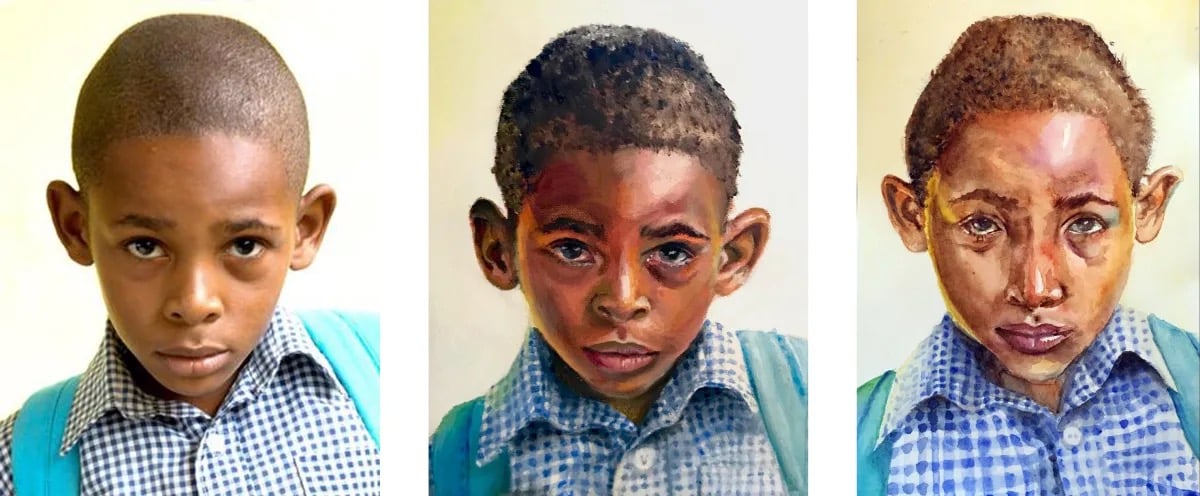In 2006, my first year at Fieldston, a 7th Grader introduced me to the Memory Project. It is a charitable, nonprofit organization that invites art students to create portraits for orphaned children from around the world who have faced substantial challenges such as violence, war, extreme poverty, and neglect. The portraits help children feel valued and important, to know that people care about their well being. They have few or no photographs of themselves, so the paintings and drawings provide a special, personal representation of their childhood. Since 2004, the Memory Project has created more than 130,000 portraits for children in 47 countries. I am pleased and so proud that our students have created many beautiful paintings and drawings for children in at least 15 (soon to be 16) of the 47 countries.
Our students have created portraits for children from Haiti and Guatemala to Ghana, Vietnam, and Syria. This year, we are being sent photographs of children from Rohingya. Below is what Ryan from the Memory Project has written regarding these children.
“This is one of our highest priorities in the past 14 years. We have just received photos of Rohingya refugee children. They belong to an ethnic minority group that has been called the ‘most unwanted’ and ‘most friendless’ group of people on earth. We would love your help creating portraits to show them they have friends in us.
You may have seen them in the news last year when they fled genocide in Myanmar, where the military was murdering them and burning their villages to the ground. Now they live in the world’s largest refugee settlement in Bangladesh, where they are slowly learning to smile again.

Creating the portraits also offers a unique learning experience for the student artists. They need to work on a deadline, do their best to capture the likeness of the child, and then give their work away. The process provides a connection to others using art as a kindness. The portraits can be no larger than 9” x 12.” Paintings are done on unstretched canvas, so there is no wood, as most paintings on canvas have. The pieces have to be light in order to be carried to the various countries. Large suitcases jammed with works on paper and canvas are carried and flown around the world to be delivered to children, who are awaiting their gifts. It is wonderful to view the videos of children receiving their portraits; links to the videos are emailed to us. The folks at the Memory Project have expanded the information on their website to include more information and videos about each country, making the experience a wider learning experience.
After the drawings and paintings are completed and dry, they are slipped into plastic sleeves. A photo of the orphan along with a photo of the artist is attached to a piece of paper. On the page, the student also writes a pre-scripted statement to the child in their language. It is provided and there are some blanks to fill in, such as the artist’s name. When I was first involved in this process, the art students would write their own notes to the children, often quite touching. I remember someone wrote how wonderful it was looking into their eyes (the orphan’s) and how they felt as if they were getting to know them. For some of the orphans, reading such heartfelt, sweet things left them emotionally conflicted. There were cases of children believing and hoping our wonderful students might adopt them. Herein lies the reason for the scripted statements.
With all the horror of families being separated and other situations that are highlighted in school assemblies, I hope creating these portraits will mean more and more to our students. It is one way to spread love and compassion around the world to children.
Here is a quote from Olivia S., a 12th Grader, who created the portraits below last year. She won a gold medal in the Scholastic Art & Writing Awards competition for her oil portrait.
“It was amazing to watch the video they made of the kids receiving the portraits. To have something that was truly theirs, some permanent record of their identity, made them so happy. I felt like I really connected with the kids on a deeper level than just donating money to charity, even though we never met them. To focus on a stranger’s face for hours really makes you think about their situation, their life, and their humanity in a different way.
It’s so important for American students to use our power and privilege to help others, especially at Fieldston where social justice is so central to our mission as a school. We focus a lot on systemic oppression as a societal phenomenon and the macro level can often take away from understanding the effects these issues have on individual people. While it is important to fix issues on a large scale, we can also perform small acts of kindness that can really make a difference when they all add up.
I actually had a unique experience giving away my piece because I didn’t realize I would have to leave it with the Scholastic Art awards people. I ended up making a second portrait in a different medium (watercolor as opposed to oil paint) and sending that instead. The process of making two portraits in two different media was really interesting and ended up being much more rewarding than just sending one. I also now have a portrait to remember Louis by rather than just sending it and forgetting.”


Below is a comment from 11th Grader Camila D. Her drawing and painting were created last year from the same group of orphans from Haiti.
“I definitely felt more pressure to make sure that I did my best work possible. I really wanted the kids to be happy with their portraits and to feel like it actually looked like them. Despite the pressure, it was a lot of fun to paint and a draw the portraits and to know that these kids would be receiving one of my artworks!
Every time I would look at the portrait of the orphans, I would imagine the moment when they would receive it, and every time I would imagine a big smile. This only motivated me to present a portrait that I knew would make them happy. Even though I never got to actually meet them, by the time I finished the portraits I felt as if we were already close friends. I knew every detail of their faces as a result of spending so much time looking at each one, but I also felt like I knew them as a whole.
I think that having portraits of themselves allows the children to be able to look at themselves in a positive and creative light. Whether it is a painting or a drawing, art inevitably brings happiness and color to everyone’s lives. These portraits emphasize how these kids deserve to look at themselves in this way. By making these portraits, I hope that the children can realize that even someone who lives so far away from them cares about them and wants to spend time making something for them. This project brings us together in an unimaginable way, and through art creates a strong relationship. It has never been easier for me to give away one of my pieces. Despite working very hard on it and being really happy with the result, I was really excited for the orphans to receive my painting and drawing. I believe art is meant to be shared, and it meant so much to me to be able to share my art with them!”



